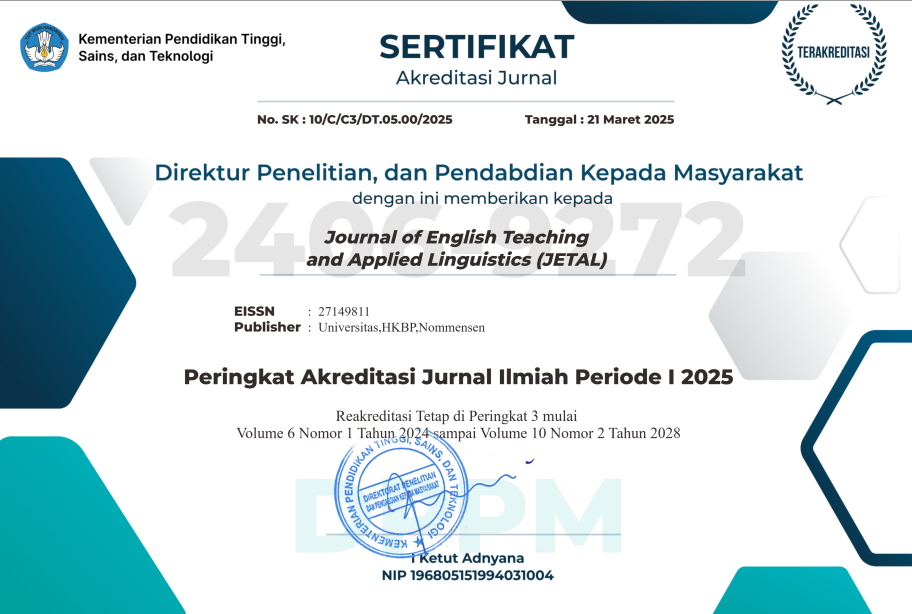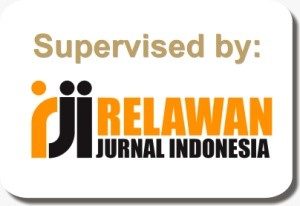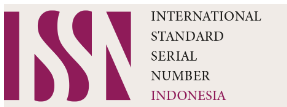Morphological and Syntactical Analysis on Advertising Billboards Used by Hotels in Banjarmasin
Abstract
It is important to have knowledge of the language to make no mistakes occur in the language. Although previous studies have discussed linguistics and advertising, it is still very rare, and almost very few have discussed the morphology and syntax of hotel billboards in detail. Therefore, to fill this void, this study aimed to examine the morphological and syntactical analysis of advertising billboards used by hotels in Banjar masin. This study used descriptive qualitative research as its methodology. The billboards from various hotels in Banjarmasin served as the study's objects and location. The researcher specifically selected the images from the billboard advertisements that were captured. Then, the data were gathered through making observations and documentation. The findings discovered in the morphology section that numerous hotel advertisements had issues adding suffixes, which were lack of suffix-ly, suffix-s/es for verbs, and suffix-s/es for nouns. Furthermore, the phrase or sentence from the existing hotel billboard has a structural flaw in the syntactic part which is difficult to distinguish with morphology elements. . This study is intended to assist lecturers in the teaching-learning process in terms of morphology and syntax. It is expected that this study would be useful to future researchers conducting pertinent literature.
References
Bauer, L. (2007). Introducing Linguistic Morphology. Edinburg, Germany: Edinburgh University Press.
Bauer, L., Kortvelyessy, L., & Stekauer, P. (2015). Semantics of complex words. Springer International Publishing.
Booij, G. (2005). The Grammar of Words. Oxford University Press: New York.
Chaer, A. (2009). Sintaksis Bahasa Indonesia pendekatan proses. Jakarta : Pt. Rineka Cipta.
Chandra, J., & Wahyuni, I. (2020). Linguistic Errors Made by Students of English Education Program in Translating Indonesia Language into English BT-Proceedings of the 7th International Conference on English Language and Teaching (ICOELT 2019). 343-350. http://doi.org/10.2991/assehr.k.200306.058.
Chomsky, N. (2002). Syntactic Structures Second Edition. Berlin : Mounton de Gruyter.
Ekwueme, J. (2020). The Contributions of Morphology and Syntax to the Study and Use of the English Language.
Fromkin. (2011). An Introduction to Language (9th ed.). Canada : Wadsworth, Cengage Learning.
Hussain, J., & Nizamani, R. K. (2011). Factors Affecting Consumer Attention in Billboards Advertising, South Asian. Journal of Management Sciences.
Kurniati. (2002). Analysis of Syntactic Error in translation. Jakarta : Universitas Gunadarma.
Leiber, R. (2009). Introducing Morphology. Cambridge University Press: New York.
Lieber, R. (2004). Morphology and Lexical Semantics. Cambridge, UK: Cambridge University Press.
Lyons, J. (1968). Introduction to Theoretical Linguistics. London : Cambridge University Press.
Mariani, N., Mu'in, F., & Arief, A.Y. (2019). An Introduction to Linguistics. Banjarmasin: Jurusan PBS FKIP Universitas Lambung Mangkurat.
McCharty. A. C. (2002). An Introduction to English Morphology: Words and Their Structure. Edinburgh University.
Meyer, C. F. (2009). Introducting English Linguistics. New York: Cambridge University Press.
Murphy, R. (2015). Essential Grammar in Use (4th ed.). United Kingdom : Cambridge University Press.
Nasrullah, Rosalina, E., & Elyani, E. P. (2020). Utilizing Learner Language to Craft Well-Targeted Endorsements in English Language Teaching Practices. English Language Teaching Educational Journal, 3(3), 254–262.
Richards, J. C., & Schmidt, R. (2002). Dictionary of Language Teaching and Applied Linguistics. London : Longman.
Rohidi, T. R. (2011). Matodologi Penelitian Seni. Semarang : Cipta Prima Nusantara.
Santosa, S. (2009). Creative Advertising. Jakarta : Elex Media Komputindo.
Shahnaz, A. (2013). Linguistic Analysis of E-print Media Advertisements in Pakistan: practices and functions. Elixir Literature, 62, 6.
Solikhah, I. (2017). Linguistic Problems in English Essay by EFL Students. IJOLTL: Indonesia Journal of Language Teaching and Linguistics, 2, 31: https://doi.org/10.30957/ijoltl.v2il.231.
Sugiyono. (2019). Metode Penelitian Kualitatif. Bandung : Alfabeta.
Verhaar, J. W. M. (2006). Asas-asas linguistik umum. Yogyakarta : Gadjah Mada University.
Walidin, W., Saifullah, I., & Tabrani. (2015). Metodologi Penelitian Kualitatif & Grounded Theory (Masbur (ed.); Edition 1). FTK Ar-Raniry Press.
Wiley, J. (2006). The Reading Teacher's Book of Lists,. Wiley & Sons, Incorporated,John.
Yule, G. (2010). The Study of Language (Fourth). Cambridge University PressPress: Edinburg.
Authors retain copyright and grant the journal right of first publication with the work simultaneously licensed under a Creative Commons Attribution-ShareAlike 4.0 International License (CC BY-SA 4.0) that allows others to share the work with an acknowledgment of the work's authorship and initial publication in this journal.
Authors are able to enter into separate, additional contractual arrangements for the non-exclusive distribution of the journal's published version of the work (e.g., post it to an institutional repository or publish it in a book), with an acknowledgment of its initial publication in this journal.
Authors are permitted and encouraged to post their work online (e.g., in institutional repositories or on their website) prior to and during the submission process, as it can lead to productive exchanges, as well as earlier and greater citation of published work (See The Effect of Open Access).






